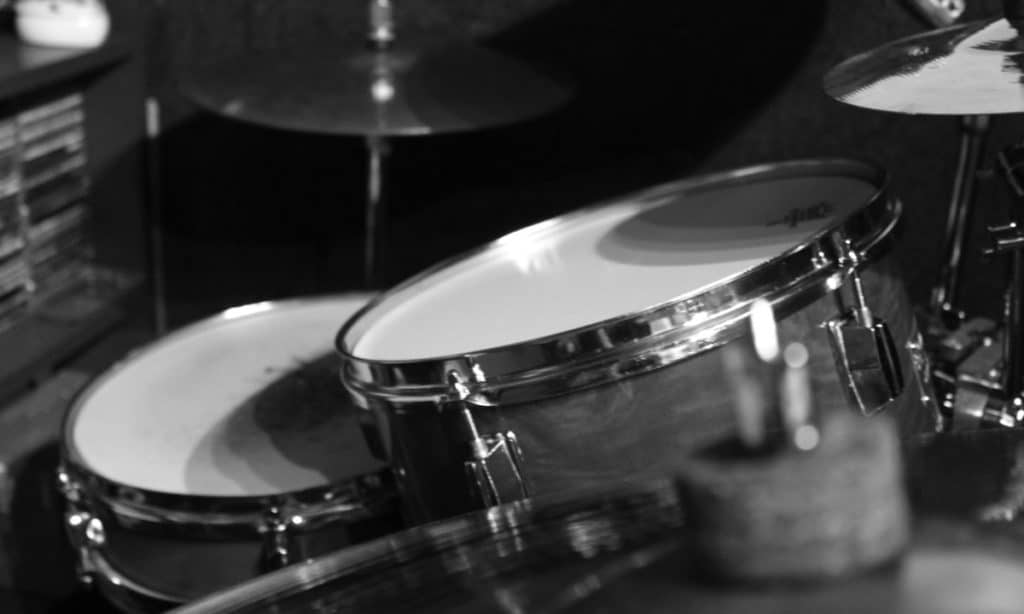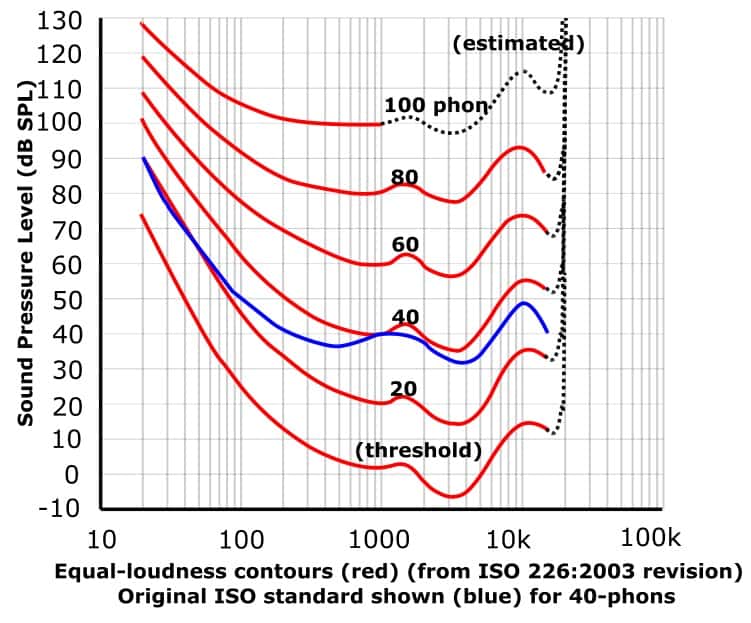This post contains affiliate links. We earn commissions if you purchase products from retailers after clicking on a link from our site. As an Amazon Associate, we earn from qualifying purchases.
I’ve thought about this question several times and I’ve never gotten a clear answer–are bigger drums actually louder than smaller drums? You would think the answer would be simple.

By the way, looking for recording equipment and musical instruments? Check out Sweetwater.com for microphones, monitors, audio interface or any other recording gear that you could ever need. (Affiliate Link)
Larger drums are not necessarily louder than smaller drums, although the capacity for higher amplitudes are possible with more surface area, several factors contribute to perceived loudness including resonance, tuning, impact strength, drum dampening, shell thickness and arguably even shell material.
So is that a yes or a no? Well, like most things in life, the answer is it depends. It turns out it’s a very difficult question to answer. Ultimately, if two drums that are exactly identical except for diameter, then the bigger drum has more potential to be louder–but practically, it may not be as straightforward. Have more questions? Let’s think about this some more.
Are Bigger Drums Louder?
It turns out the answer is pretty controversial–many drummers swear that bigger drums are louder, and others swear the exact opposite.
Some appeal to physics, and some do not–I decided to take a dive in to try and understand all the parts to see if we can make sense of the answer.
Although bigger drums move more air than smaller drums, they are not necessarily louder due to several factors including drum pitch and drum resonance.
In any case, a larger drum has the potential for a higher amplitude. Whether it actually sounds louder is much more complicated.
What Is Loud?
When I first started learning about sound design, I thought loudness just meant more power.
Loudness Isn’t Amplitude

In other words, in my brain, I thought that sound A should always sound louder than Sound B (see figure 1). In other words, I thought: amplitude equals volume.
It turns out that I didn’t know that things were way more complicated.
First off, our human ears are logarithmic in the way we perceive how loud something is.
What do I mean by logarithmic?
Well, first I can explain the mathy way:

Logarithmic in this context simply means as the inputs gets larger, the output doesn’t grow as fast.
A more understandable example is that a thunderbolt at a close distance is going to sound just as loud to us as the inside of a volcanic explosion. Our brains can’t distinguish at all between the actual amplitude of a sound.
This same is true for quiet sounds. If a sound is only a single decibel different (let’s say dBFS), than the same sound a decibel louder, then chances are our brains won’t notice the difference.
It turns out our hearing is actually logarithmic–similar to all of our senses, actually. And sometimes it takes a tripling of actual amplification (power) before a sound volume “doubles”. But it’s even more complicated than that!
To summarize this section–amplitude does not mean volume.
Human Hearing And the Bell Curve
It turns out that frequency plays into how loud something sounds to us. No matter how big a bass drum is will not make it seem as loud as someone playing the triangle right next to us.
When I think of that… that sounds like the worst experience in the world.
Depending on how high or low something is plays into how well we can hear it.

The Fletcher–Munson curve, depicted above shows what the dB SPL would have to be for frequencies from 10 HZ to 10K HZ for a human to perceive as constant volume
To simplify and interpret this curve:
- Bass frequencies Require WAY more power for us to perceive them as the same volume as high frequencies
- Our ears are really great at hearing frequencies from around 100 HZ to 1000 HZ, which happens to be where human speech and musical instruments hang out.
- Our human ears are especially sensitive to frequencies around 3000 HZ to 4000 HZ (Guess what hangs out here? Cymbals!)
- Super high frequencies (around 10K) also need a kick in power for us to perceive them at the same volume as other pitches
So, depending on the frequency of a sound will affect how loud we perceive it.
This is even more complicated by the fact that this human hearing curve (figure 2), is only an approximation and is actually different for each person.
What this means for drums is that the high tom might actually sound louder than the low tom at times!
Attack And Why It Matters
One of the most important ways we perceive loudness is the length of the sound!
You’ve all been there when a fire alarm goes off, and that constant alarm sound feels louder and louder as time goes on. If the fire alarm was only a blip of sound less than a 1/4 of a second, it wouldn’t feel nearly as loud!
Another example is if you were to strike a bell with a mallet and then immediately grab it–this bell wouldn’t sound nearly as loud as a bell that you strike and allow to resonate.
Longer sounds will sound louder to us than shorter sounds.
This matters for drums, since drums can resonate more or less depending on the tuning of the drumhead. If your drums resonate more, they will sound louder.
Drum Loudness Factors
So we learned a bit more about how we perceive loudness, let’s figure out how this lines up for drums.
There are several aspects of drums that can contribute to how loud the drum is
- Wood Density: I doubt there has been a lot of scientific study on this, but the commonly accepted idea is that denser woods (such as maple) will cause the resonance of the sound to be stronger than a less dense wood (pine). We do know that the more a tone resonates, the louder it sounds.
- How Hard You Strike the Drum: Drums make sound because you are exciting air molecules when you strike the drumhead that than vibrate other air molecules that eventually vibrates your ear drum, which is where we perceive the sound. The harder you strike the drum, the more excited the air molecules, therefore the greater the amplitude (and most often the loudness of the sound).
- Drum Size: The longer the diameter of the drumhead, the more air molecules that will be excited when you strike the drumhead. A tiny one-inch drum will probably never sound as loud as a drum with a 10 foot diameter. However, it gets a little fuzzier when the diameters are closer together and there is only a difference of a few inches in diameter.
- Drum Tuning: A popular belief is that tuning can impact drum loudness. Each drum has a resonance frequency that the shape and size of the shell will resonate most strongly with, and the theory is that the drum can be tuned in such a way so that this frequency resonates the most strongly with this frequency.
The Answer
So, let’s get back to the question, does this mean that bigger drums are louder?
Well now that we have the answer, the answer is not necessarily.
Let’s say you have a 10″ high tom and a 16″ floor tom. If you strike the two drums with exactly the same force, there are several reasons why the higher tom might actually sound louder:
- The high tom is a much higher pitch than the floor tom, and we learned above that lower pitches must be at a much higher amplitude to be the same loudness as higher pitches.
- The high tom could be tuned in such a way that it resonates more and longer. If this is the case the high tom will sound louder. The opposite could be true as well. If the high tom is tuned so that there is little to no resonation, then the low tom will likely win in volume
- If the low tom is tuned rather low, then the drumhead energy will be lower–thus, the pitch and amplitude will be lower.
However, if the low tom is tuned higher and you strike it with enough force, then there is going to be more potential for the lower tom to have a higher amplitude. Does this mean it will sound louder? Well, that depends on the pitch.
How To Increase Drum Loudness?
So, by now, we should understand that buying a drumkit with huge drums doesn’t meant that we will sound louder than if we were using smaller drums. Bigger drums have a higher potential for bigger amplitude but there’s not a guarantee you’re going to be heard better.
Why Tuning Matters
Resonance is key if you want to be heard. A drum that is “dead” or where the sound dies as soon as you strike the drum is not going to carry through a mix nearly as well as a drum that resonates.
Although more resonance = more perceived volume, that might not be the sound you’re looking for. Lots of drummers have experienced the snare that just won’t shut up and they resort to muting the snare to try and deaden the high-pitched resonating of the drum.
Your resonance can be hugely affected by your tuning. Check out some more in depth videos on tuning drums to see how to tune your drums and see how it can affect the sound:
You can hear even in this video how the sound is much easier to hear as the drum gets tuned–the drum resonates and feels louder.
Also, some say that tuning both sides of the drum at the same time makes it easier to do this process evenly.
Projection
Deeper drums can project more than shallower drums, as the air will travel a longer distance before dispersing. If you’re having trouble cutting through the mix, getting deeper drums might be one thing to look at.
